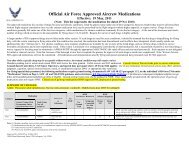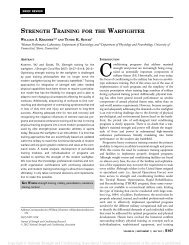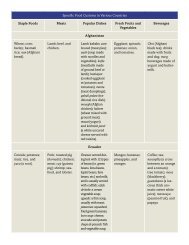Force Health Protection: Nutrition and Exercise Resource Manual
Force Health Protection: Nutrition and Exercise Resource Manual
Force Health Protection: Nutrition and Exercise Resource Manual
Create successful ePaper yourself
Turn your PDF publications into a flip-book with our unique Google optimized e-Paper software.
4 ft. lengths <strong>and</strong> cost $5 to $10. When purchasing tubing, buy one with<br />
h<strong>and</strong>les large enough to slip over your forearms. Buy several tubes of varying<br />
widths since you will need different resistances for different exercises. Also,<br />
check the tubes periodically for wear <strong>and</strong> tear.<br />
Inflatable Resistance Balls<br />
These light-weight balls are becoming very popular in<br />
fitness centers <strong>and</strong> are excellent for abdominal, lower back,<br />
stability, <strong>and</strong> stretching exercises. The goal in resistance<br />
ball training is to keep your balance <strong>and</strong> stability while<br />
performing exercises on the ball, which acts as an unstable<br />
base. Resistance balls are typically 18 to 30 inches in diameter <strong>and</strong> cost about<br />
$30. Purchase a resistance ball that when you sit on it after it is fully<br />
inflated, your thighs are parallel to the deck. In addition, when you purchase<br />
these balls, you get a video of various exercises <strong>and</strong> routines. One drawback<br />
is that you need access to an air pump because, if the ball is kept inflated,<br />
it can take up a lot of storage space.<br />
Strength <strong>Exercise</strong>s<br />
Table 10-1 shows exercises that can be performed using resistance tubing<br />
(b<strong>and</strong>s) <strong>and</strong> balls. When performing elastic tubing exercises, you can use a<br />
partner, instead of an anchor, to secure the tubing during your exercise. Just<br />
be sure your partner holds the tubing at the appropriate height <strong>and</strong> distance<br />
from you (<strong>and</strong> doesn’t let go!). When using the resistance b<strong>and</strong>s, it is<br />
important to anchor them properly. Some examples are shown in Figure 10-1.<br />
1.<br />
Figure 10-1. Anchoring Elastic Tubing<br />
1. Wrap the b<strong>and</strong> around the top <strong>and</strong> sides of both feet, then pull<br />
the h<strong>and</strong>les up through the middle of your feet. This type of wrap<br />
is useful for anchoring the b<strong>and</strong> during rowing exercises.<br />
2.<br />
2. a. Using the 1 ft. elastic loop, sit down <strong>and</strong> place your right foot<br />
on the middle of the loop.<br />
b. Wrap the right end of the tubing over your foot.<br />
c. Pull the left end of the tubing up through the right end of the<br />
tubing loop.<br />
d. Take the left end of the tubing loop <strong>and</strong> wrap it around your<br />
left foot.<br />
This type of anchor is useful for leg lifts <strong>and</strong> leg curls.<br />
<strong>Nutrition</strong> <strong>and</strong> <strong>Exercise</strong> <strong>Resource</strong> <strong>Manual</strong> 79






![Body Composition and Military [PDF] - Human Performance ...](https://img.yumpu.com/43269347/1/190x245/body-composition-and-military-pdf-human-performance-.jpg?quality=85)
![Tips for Grocery Shopping [PDF]](https://img.yumpu.com/37447379/1/190x245/tips-for-grocery-shopping-pdf.jpg?quality=85)



![Synthetic Drugs [PDF] - Human Performance Resource Center](https://img.yumpu.com/37447322/1/190x245/synthetic-drugs-pdf-human-performance-resource-center.jpg?quality=85)


